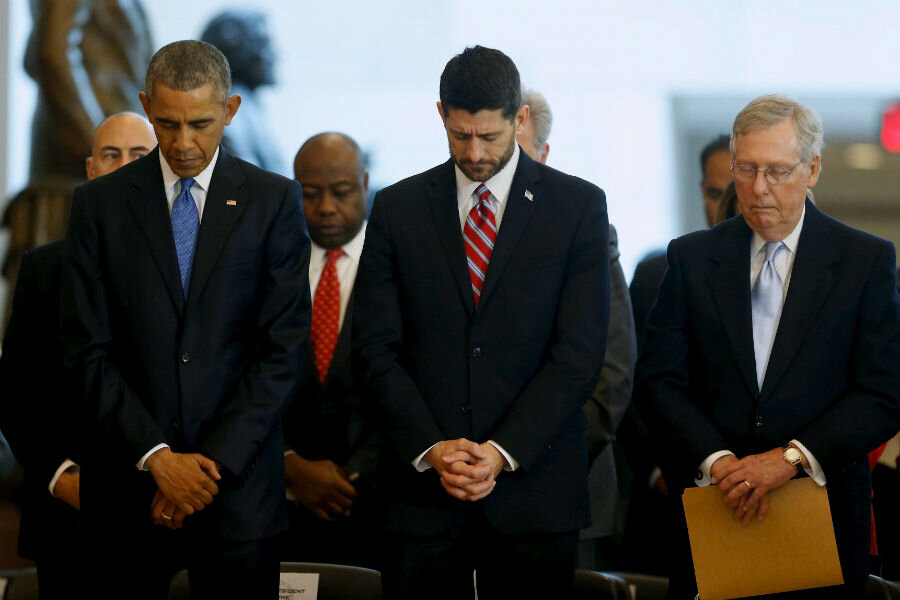Why does the religious make-up of Congress look different from that of America?
Loading...
Even as the percentage of Americans who claim no religious identification has risen to nearly a quarter of the population, 91 percent of representatives in the current Congress self-identify as Christian – about the same amount as in 1961 – according to an annual analysis from the Pew Research Center.
That doesn’t mean the religious composition of Congress hasn’t changed at all: the share of Catholics has climbed substantially, from 19 in 1961 to 31 percent today, while the share of Protestants has fallen, from 75 to 56 percent, over the decades. And while the share of Jews has remained roughly the same since the early 1980s, more Buddhist, Mormon, and Muslim politicians have now been elected to Congress, in proportions that more or less reflect those of the general public.
“The group that is most notably underrepresented is the religiously unaffiliated,” writes Pew, whose study uses data compiled by CQ Roll Call. “This group – also known as religious ‘nones’ – now accounts for 23% of the general public,” while only one member of Congress – Rep. Kyrsten Sinema (D) of Arizona – lists no public religious affiliation.
That gap may illuminate the enduring importance of religious institutions in American public life, despite a decrease in the number of people who actively identify as members.
Part of the reason for the gap, says John Green, a political scientist at the University of Akron, has to do with the social characteristics associated with success in politics.
“Members of Congress tend to be well-educated people, from professional backgrounds – particularly lawyers – well into their professional careers, so they’re middle-aged, and active and engaged in the community. Religious organizations are really important parts of most communities in the United States,” he tells The Christian Science Monitor in an interview Tuesday.
The connectedness often afforded by religious denominations often contrasts with the habits of the “nones,” who tend to be less engaged in community life, he adds.
“They also tend to be younger and well-educated, though, so it could be that over time, as younger unaffiliated people come into middle age and get well-established into their professions, you could see greater representation in Congress,” he says.
Such networking also happens on the Hill itself, even inspiring the occasional bipartisan effort, as the Monitor’s Francine Kiefer wrote in September in a profile of congressional prayer meetings:
The prayer breakfast is one of the few venues on the Hill where members of both parties mix socially. In a typical week, about a quarter of the Senate shows up, including members of leadership from both parties, according to [Sen. Chris Coons (D) of Delaware]. Participants drop politics at the door. They observe strict confidentiality. No staff. No journalists. It’s just the senators and the chamber’s chaplain, who leads the singing.
The Senate breakfast and its companion in the House are invisible to the public. Yet that is exactly what makes them so beneficial, say attendees. The confidentiality of the breakfasts allows lawmakers to get to know each other as human beings. They hear about each other’s personal struggles and joys, about concern for family members, friends, and staff. That builds trust and friendship. It can even lead to bipartisan legislation. One participant says that it’s the only time when a senator is speaking and others are really listening.
Some politicians' decisions to list an affiliation are likely shaped by an assumption that they'll miss out on votes if they don't.
“If you think about the distribution of where you find the secular population in the US, this makes sense,” David Campbell, a political scientist at Notre Dame University who has written several books on religion in US politics, tells the Monitor. Less religiously-inclined voters tend to be spread out across the country, meaning they don’t really form a geographic bloc.
“We also know from other data that while religious voters might be wary of a non-religious candidate, it doesn’t go the other way: non-religious voters are still open to voting for politicians who do have a religious affiliation,” Dr. Campbell adds.
And many voters whom studies label as “nones” may still see a candidate’s faith in a positive light, since many are “passively” secular, rather than actively opposed to organized religion, he says. Some might still see the morality of a politician as being tied to his or her religion. Others might be just fine with fewer separations between church and state – and vote for lawmakers who are, too.
Other surveys periodically turn up fluctuating enthusiasm for more religion in politics. In 2014, for instance, 41 percent of respondents told Pew said that there was “too little” religious expression from political leaders, marking a modest rise during Obama’s term in office.
“It may not be their thing, but a lot of ‘nones’ see it as a source of moral values, as a way of bringing people together,” says Dr. Green. “Even if they may not be religious in a formal sense, they may still have positive views associated with it.”







